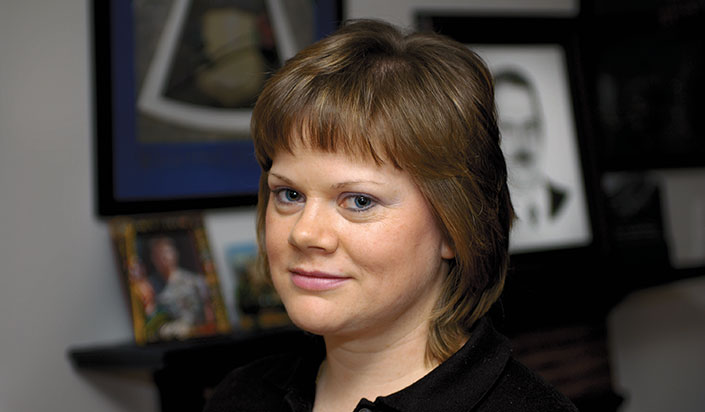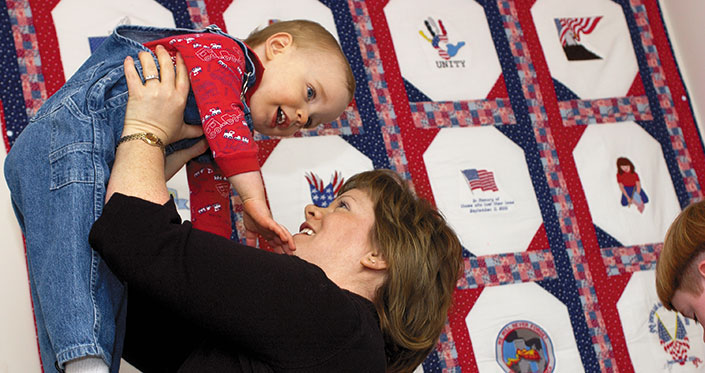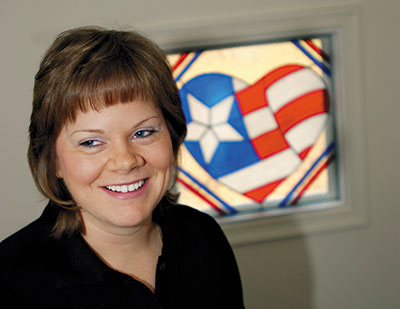
This article was first published Sept. 2003 in NRA's Woman's Outlook.
It was a phone call that would eliminate all doubt and, at the same time, eliminate all hope. In the months that had passed since 9/11, Holly Miller, a former editorial assistant in the NRA Publications Division, lived with the knowledge that her husband, U.S. Secret Service Master Special Officer Craig Miller, who was on temporary duty in New York City during the terrorist attacks, likely perished when the Twin Towers fell. Craig’s body, like so many others, had not been recovered. And though logic and reality dictated that Craig would never come home to Holly and their four boys, there was always something in the deep recesses—the illogical, hopeful part—of her brain that said, “maybe.” And “maybe” meant there was hope, particularly for Holly’s eldest sons, Robby and Cody, to whom Craig had been Dad since they were in kindergarten.
On May 15, 2003, one of Holly’s friends from the Secret Service telephoned to say he planned to visit later that day. The support network she’d come to rely on—co-workers of Craig’s—stopped by regularly, so his call wasn’t unusual. But when Holly opened the door to her friend, he was standing with other agents she hadn’t expected, and she knew it would be no ordinary visit. The news they delivered was what she had been dreading for 20 months: There had been DNA identification of remains found in the rubble of the Towers. The engineers, who had painstakingly identified all that was taken from the site, at last had made a positive match to Craig. There would be no more doubt.

As It Unfolded
On the morning of September 11, 2001, a dozen or more NRA Publications employees and I crammed into the tiny division library to watch TV news coverage of the shocking scene unfolding before our eyes. The second plane had just flown into Tower 2, and flames were rapidly consuming Tower 1.
Noticing Holly’s absence, I hurried to her desk. “You’ve got to see what’s happening!” I said, breathless.
She shuffled some papers, seemingly preoccupied, and said simply, “I can’t.” I assumed she meant she had too much work to do.
“You’ve got to,” I implored, as I briefed her on the events. Holly picked up a yellow notepaper. She handed it to me and said emphatically, “No, I can’t watch it.”
On the paper were the words, “Twin Towers Marriott” along with a phone number. “That’s where Craig’s staying while he’s on TDY,” she said.
I gasped. Although in my heart I believed Craig had gotten out of harm’s way—after all, he had just finished his night shift and was supposedly at the hotel sleeping—I felt sickened that I couldn’t offer absolute reassurance.
NRA Secretary Edward Land sat with Holly as she waited for Craig’s call. Other employees came by to offer words of encouragement. As word spread of the subsequent attack on the Pentagon and plane crash in Shanksville, Pa., we insisted it would be best for her to await his call at home. Reluctantly, she agreed. Many area schools were closing. The boys would have so many questions, and she hoped she would soon have answers for them, for Craig’s parents, her parents and for herself.

Fast Friendship
Holly and I had become fast friends when she returned to work from maternity leave several months earlier, about the time I started working at NRA Headquarters. She and Craig were the proud parents of twin boys, Colton and Curt, and were still acclimating to their new routine. Craig held “daycare” duties and managed to sleep for a few hours between Holly’s arrival home from work until he departed for downtown Washington, D.C., where he worked “midnights” for the Secret Service.
Craig had been part of the NRA family for many years. Prior to being hired by the Secret Service, he was a part-time range officer at NRA Headquarters, where he and Holly met. He was also an NRA Law Enforcement Firearms Instructor and had served in Desert Storm while on active duty in the U.S. Army, earning two Bronze Stars.
As NRA Life members, Craig and Holly were committed to preserving Second Amendment freedoms, but they were first and foremost deeply committed to their four boys. Craig often called Holly during the day to update her on the latest feats of the twins and e-mailed her the silly poses of them he captured on camera.
The last time Craig gathered with his NRA family was at the annual NRA picnic in late August 2001. As we sat at the picnic table eating barbecue and burgers, Craig lamented over Holly’s dislike of onions and insisted she not influence the babies toward that same dislike, as she had with Robby and Cody. “Nope,” she laughed, “Onion hater! Onion hater!” pointing to each baby, then six months old. They argued about it playfully, but Craig’s word was final. His boys would definitely develop a taste for onions if he had anything to say about it.

How To Go On?
Holly’s parents were also heartbroken over losing Craig, whom they considered a son, and took early retirement from their jobs to relocate across country in Virginia to help care for the boys. But despite the immense outpouring of support from her friends, family and nationwide NRA family, life after 9/11 left an enormous void in Holly. The following months consisted of a whirlwind of memorial services in Washington, D.C. and New York, as well as a special tribute to the heroes of 9/11 at the NRA Annual Meetings in Reno, Nev. The year culminated with the one-year anniversary of the attacks and a nationally televised service at Ground Zero.
“So many people have said, ‘I don’t know how you did it,’ ” says Holly. “To be honest, some days I wonder myself. But you just dig in and do what you have to do. I was still my children’s mother and they needed me to change a diaper or make a sandwich, kiss a ‘boo-boo’ or ‘check out’ what cool new thing they could do. So at the end of the day, after all the company had left and the house was quiet, I was still the mom. The love of my children saved me.”
Gradually, Holly emerged from the grieving process. Through it all, she never let go of her nurturing spirit, and more often than not, it was Holly who comforted those around her who were having a difficult time with the loss.
“Everything I did was for the boys. They needed to see their mom being strong so they could feel safe and secure. It was harder on Robby and Cody at that time because they became fearful that something would happen to me and take me away, too.”
So Holly made certain changes around the house. “I had the cable disconnected so we could focus on something other than the perpetual TV coverage of September 11,” she says. “As a result, we did other things like ‘shoot hoops’ in the front yard, cook at home and eat at the dining table. I became more involved with their interests and we became that much closer.”
There were also events that were planned for the family: a hockey match fundraiser in North Carolina, a summer trip to Florida and a visit to the White House. On September 11, 2002, at Ground Zero in New York, Holly met President Bush and First Lady Laura Bush, as well as members of the president’s staff including National Security Advisor Condoleeza Rice and Secretary of State Colin Powell. “Their powerful and confident presence further strengthened my resolve,” she says.
“The cruel irony is that Craig would have loved so much to do all those things with us, but we were only doing them because he wasn’t here, because he gave his life supporting his country and his president. And even when I could let go and laugh with the kids, I’d feel pangs of guilt wash over me. I would think, ‘He should be here. He should get to hear his babies laugh.’”
There were also regular visits to New York, which proved to be the most difficult for Holly. “A full month had passed before I could bring myself to see Ground Zero for the first time. At that moment I wanted to be on the outside of it, to be one of the thousands of bystanders, clinging to the outer fence, praying for us,” she says. “It made me remember countless other times when I’d seen a crime victim’s picture on the television screen, and I’d shake my head and feel pity for their families, but I could turn off the power button and go back to my own life. I could not do that now. This was my life, and I couldn’t figure out how this happened to us.”
A New Start
On September 9, 2002, exactly one year after Craig left for New York, Holly returned to work—only it was to U.S. Secret Service Headquarters in Washington, D.C., where she would be working in an administrative capacity with former colleagues of Craig’s. As a co-worker, Holly felt connected to them and closer to Craig.
“It was what I needed then—to be where he was, to see what he had seen, to hear stories about him at work, to be around other people who cared for him. They made me laugh and they were comfortable when I talked about him, too. Nobody walked on eggshells, and I felt like I was a part of his work family,” she says.
Choosing not to return to NRA Headquarters was a difficult decision for Holly because she had loved her job, but there would be too many reminders of the past such as the routine brief “I love you” phone calls and e-mails from Craig. It would never be the same, she thought.
“I will always feel a part of the NRA family. The way NRA members—most of whom I’d never even spoken to—offered their support to me, a complete stranger. It told me what I already suspected—that I was working for one of the most patriotic organizations in the country with some of the most sincere people, whom I’d probably never meet. So many people reached out to us because they felt they knew Craig, as a serviceman, policeman or rescue worker, or just an ordinary hardworking American doing his job. That really is the NRA.”
Memories
Holly will always have Craig with her in the twins and, as they grow, there will be subtle reminders of him of which only she will be aware. But other, intentional daily reminders of him will be present also. Symbols of patriotism are evident throughout her home in many forms: the red, white and blue mantel dedicated to photographs of Craig with the family, his professional accomplishments, and framed pictures of the National Law Enforcement Memorial. In the sunroom hangs a “Patriot’s Quilt,” handmade by Brenda Williams, who is from Holly’s hometown in Arkansas. Each square represents a memory of Craig…his Army helmet, his Secret Service Star, the U.S. Capitol, the Statue of Liberty, eagles and flags, and a square in the center that says “America Will Always Remember The Twins,” flanked by the two towers. In the hallway is a stained-glass window with a red, white and blue heart, crafted by the wife of a victim of the 1995 Oklahoma City bombing of the federal building. And then there is the Beretta shotgun that Craig ordered as a surprise birthday present for Holly after she joined the NRA skeet league. It arrived at NRA Headquarters two weeks after 9/11.
In the springtime, red, white and blue pansies are planted in a memorial garden in the front yard under two mature oak trees. The pansies complement the giant U.S. flag that flies between them. It’s a visual reminder of the strength of the two towers, flag proudly waving still. Buried in the garden below is a jar containing sand and rubble from Ground Zero, a symbolic gesture that offered comfort shortly after the tragedy when Holly had nothing tangible to lay to rest. Nearby in the driveway sits Craig’s other love—a fiery orange Camaro that now bears a personalized license tag, “PHNIX,” which Holly worked so hard to get back after hastily turning it over to the bank while she struggled financially immediately post 9/11.
The twins, Colton and Curt, will never know their dad in the way that most children do. They will see pictures of him, but they will know him by what is told to them by their mom and brothers and grandparents, and by friends who will relate stories of his heroism and his devotion to his family.
And when they’re old enough they, in return, can offer tribute to their dad with the outwardly insignificant act of eating their hamburgers loaded with onions.

This stained-glass window was crafted by Diane Leonard, wife of Don Leonard, who was lost in the 1995 Oklahoma City bombing. It overlooks Craig’s memory garden, which can be seen directly from the twins’ bedroom. Upon completion, it was flown on President George W. Bush’s car plane from Oklahoma City to Washington, D.C. The window was installed in the wall on September 11, 2002, as Holly was standing at Ground Zero. Here is what the image represents: The heart pattern stands for the way Craig did his job—with heart. The four corners represent the four boys. The bumpy lines in the corners represent the bumps in their road traveled. The two vertical lines in the heart reflect their hearts broken on September 11, and the bumps in the lines are their tears. The five points of the star reflect Holly and her four sons. The blue surrounding each of the points shows that no matter what, Craig will always be around them. The thick circle in the center of the star represents the sun that they will one day see again.





































